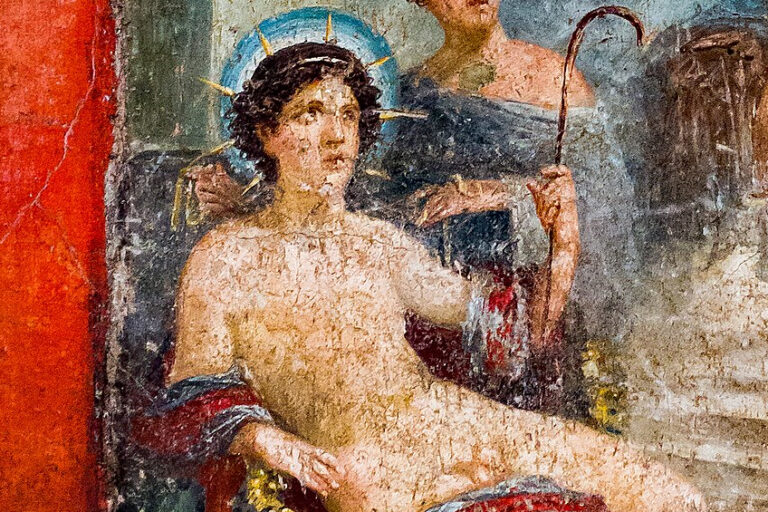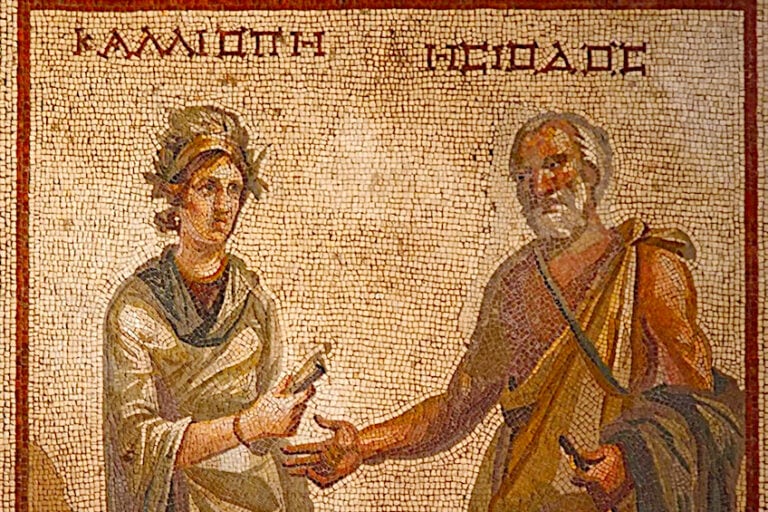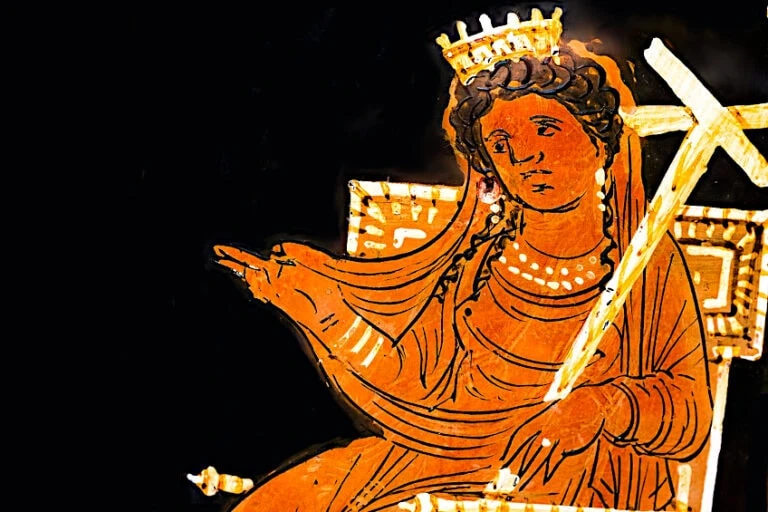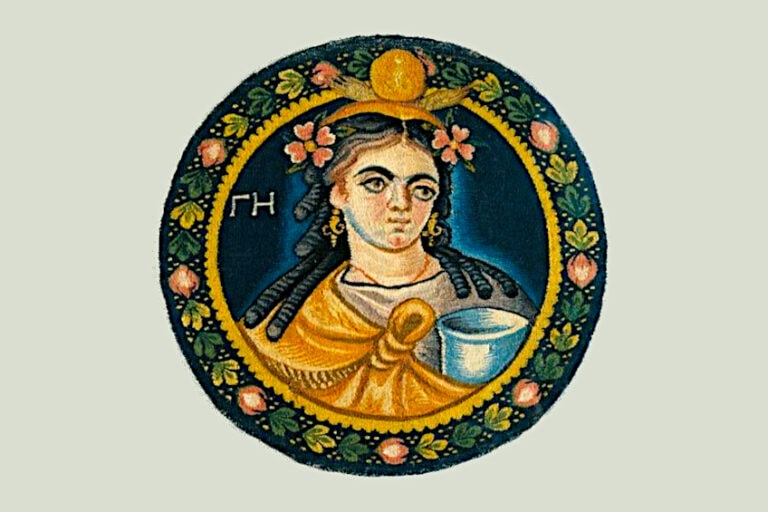Greek God Hades – The God of the Underworld
Who did the Greek God Hades choose to be his wife and what is Hades the god of? Hades is the Greek god of the mythological underworld, and his consort is his niece, Persephone. This article will explore the mythology of the Greek god Hades, discover Hades’ symbols, and answer questions such as, “did Hades have children?”, and “what was Hades’ domain?”. Join us as we find out why the god of the underworld is so significant in the Greek pantheon, and discover the role he played.
Contents
What Is Hades the God of in the Greek Pantheon?
| Name | Hades |
| Gender | Male |
| Symbols | Cypress, cornucopia, serpent, mint plant, and keys |
| Personality | Stern, pitiless, forbidding, and aloof |
| Domains | The underworld |
| Parents | Cronus and Rhea |
| Spouse | Persephone |
 Hades/Serapis with Cerberus, mid-2nd century AD statute from the Sanctuary of the Egyptian; Carole Raddato from Frankfurt, Germany, CC BY-SA 2.0, via Wikimedia Commons
Hades/Serapis with Cerberus, mid-2nd century AD statute from the Sanctuary of the Egyptian; Carole Raddato from Frankfurt, Germany, CC BY-SA 2.0, via Wikimedia Commons
Like death, Hades was portrayed as austere and pitiless, unaffected by sacrifice or prayer. Even in the Greek story of his kidnapping of Persephone, he never appears as a distinct individual from the shadows of his realm. Those dark and unknown characteristics were balanced out by an opposing and helpful side. The god of the underworld was often worshiped as “Good Counsellor” (Eubouleus), or “the Renowned” (Clymenus).
The Greek God Hades’ Background and Family
Hades translates to “The Unseen One”, which is an appropriate title given that the Greek god Hades is the lord of the unseen world. However, the name was rarely employed by the Ancient Greeks, much as the word “Hell” was seldom utilized by Christians during the Middle Ages. Because minerals and valuable metals are located underground, they are known to Hades as Plouton – essentially, “The Wealth-Giver”. Pluto is Hades’ Roman equivalent. Many of the people of Ancient Greece referred to him as the Infernal Zeus, as well as “the host of many”, as all would eventually serve him in the end.
Hades is referenced a total of 10 times in the “New Testament” in its original Greek form as the land of the dead.
While the Greek god Hades is sometimes portrayed as a harsh, cold-hearted ruler, his personality is quite complicated and often misinterpreted. Contrary to popular misconception, Hades was neither the personification of evil nor a judge of the departed; instead, he was a stern but just ruler who ensured that souls who reached Hades’ domain were treated in accordance with their actions in life. Although Hades and Thanatos, the god of death, are often confused, their duties and responsibilities were actually quite distinct.
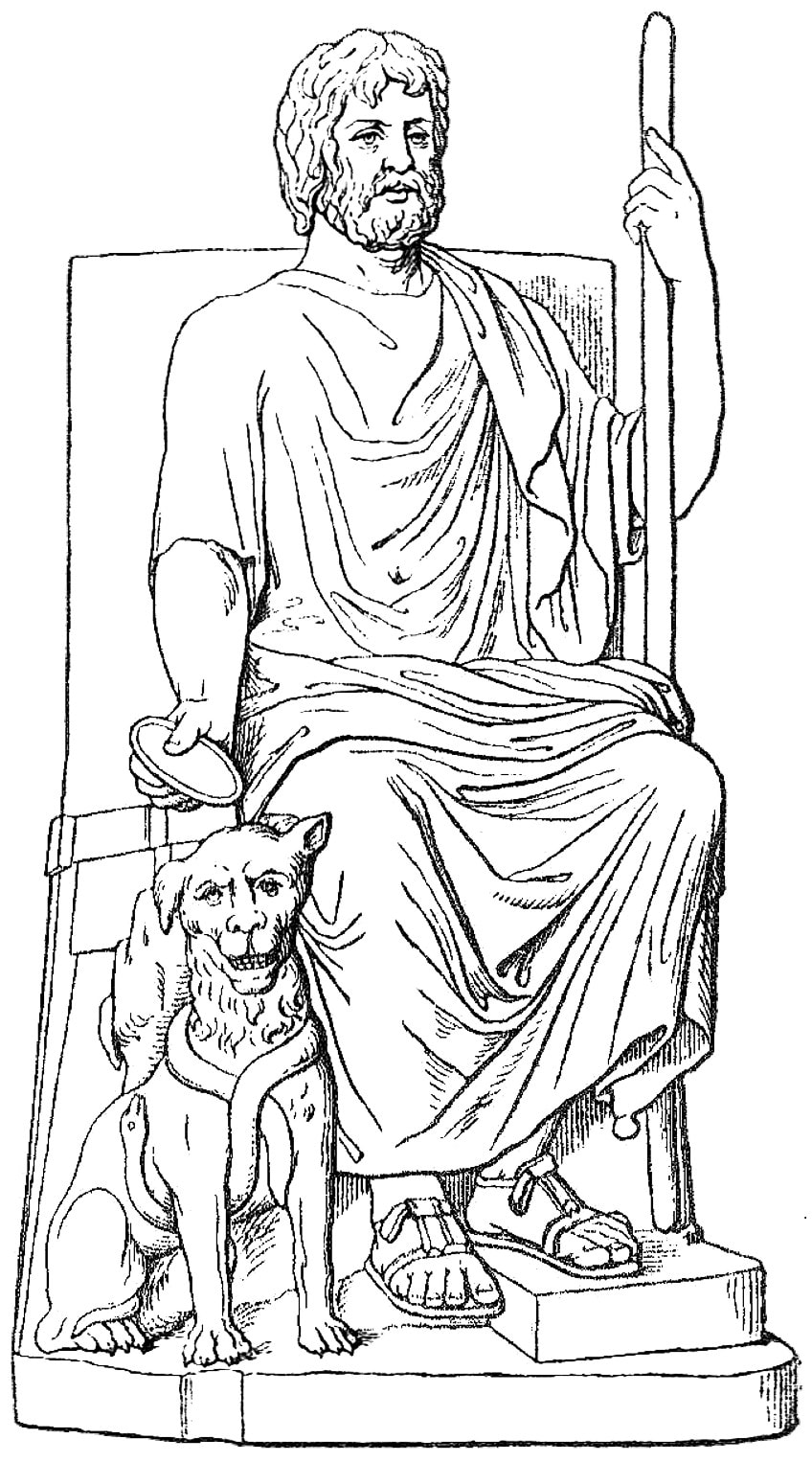
Hades and Cerberus, in Meyers Konversationslexikon, 1888; See page for author, Public domain, via Wikimedia Commons
Hades ruled over the Underworld, while Thanatos was in charge of overseeing death and escorting souls to the afterlife. Hades was regarded as an important element of the cycles of life and death, helping to keep balance and order. Unlike the other Greek deities, Hades had very few dedicated temples and was not widely venerated by the general population. This was because the Ancient Greeks were hesitant to invoke his name for fear of arousing his attention and unleashing tragedy.
But there were other mystery cults, such as the Eleusinian Mysteries, that featured Hades and Underworld rituals.
Family of the Greek God Hades
Hades was the first-born son of the Titan gods Cronus and Rhea, and he had three elder sisters, Demeter, Hestia, and Hera, along with a younger brother, Poseidon, who were all devoured whole by Cronus, their father, immediately as they were born. Zeus was the only one who had spared this destiny thanks to the interventions of Rhea, their mother. Zeus was able to convince his father to regurgitate his siblings when he reached maturity. Following their liberation, all six younger deities along with whatever allies they were able to muster, fought the elder gods for supremacy in the divine war known as the Titanomachy. The conflict lasted 10 years and concluded with the younger gods being triumphant. Following their triumph, Hades, Poseidon, and Zeus, drew lots for which domains they would rule over.
Zeus was given the sky, Poseidon was given the oceans, and Hades was given the underworld, the invisible region where the souls of the dead go when they die.
The Significance and Role of the Greek God Hades
Hades presided over the dead with the help of those over whom he had absolute authority. The House of Hades was said to be filled with “guests”, and he hardly ever departed the underworld. He didn’t care what occurred in the world above since his major concern was that none of the people he controlled ever left Hades’ domain. Hades forbade those under his rule from leaving his dominion and became enraged if anybody tried to flee or take souls from the underworld.
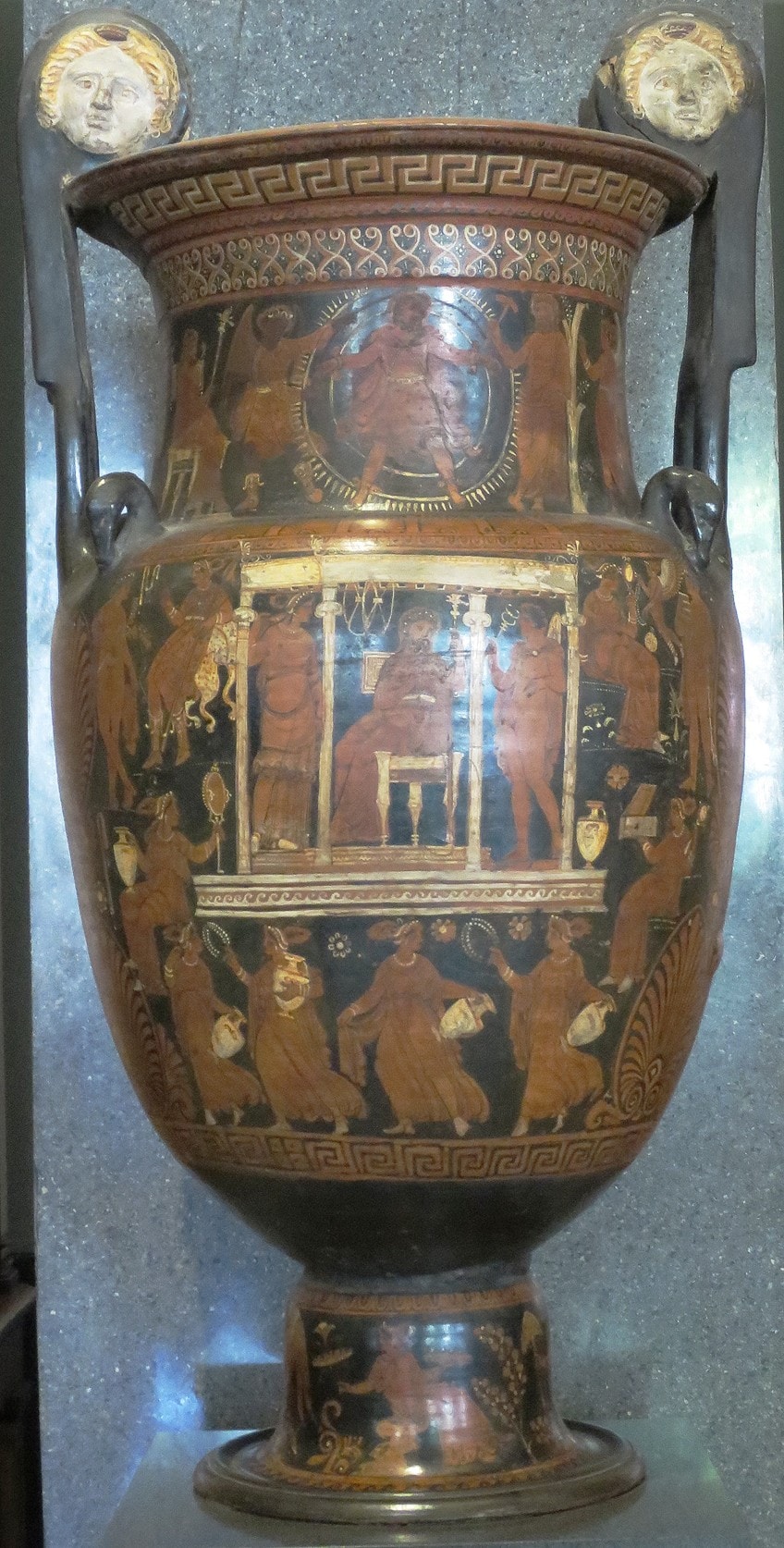 Red figure volute krater with a scene of the Underworld with Hades, Persephone, and Hermes in the palace and the Danaides below; Wmpearl, CC0, via Wikimedia Commons
Red figure volute krater with a scene of the Underworld with Hades, Persephone, and Hermes in the palace and the Danaides below; Wmpearl, CC0, via Wikimedia Commons
As Pirithous and Sisyphus discovered to their detriment, his anger was equally horrible for anybody who wanted to evade death or otherwise angered him. While the Greek god Hades was typically uninterested in his subjects, he was obsessed with punishing these two people, especially Pirithous, who traveled to the underworld to try to capture Persephone for himself. In Greek mythology, Hades was only represented outside of the underworld once, and it is thought that this happened when Heracles wounded him with a bow and arrow as the Greek god Hades was trying to protect the city of Pylos. He did, however, fly to Olympus to recover after being wounded.
The Personality and Traits of the Greek God Hades
Hades was characterized as passive and never unfavorable, as the purpose of his existence was to preserve some sort of equilibrium. However, he was also often characterized as cold and austere, and he held all of his people equally accountable under his rules. He is often viewed as somewhat enigmatic, as he keeps to himself and seldom interacts with other deities or mortals. This preference for isolation leads to him being portrayed as a somber deity. Despite his associations with death, Hades does not purposefully aim to inflict damage or pain.
He mostly deals with his position as a custodian of the underworld and balancing the worlds of the living and deceased.
Other characteristics of his personality are not mentioned since the Greeks avoided giving him much thought in order to avoid attracting attention to themselves. Hades, as the god of the underworld, was a terrifying figure to people still alive; they were hesitant to take pledges in his name and covered their faces when offering sacrifices to him. Because the name “Hades” was scary to many people, euphemisms were used instead. To ensure that Hades heard their prayers, the Greeks slammed their palms on the ground. He was typically worshiped with the sacrifice of black animals such as sheep.
The Physical Appearance of the Greek God of Hades
Hades is often depicted with a dark and thick beard that reaches down to his chest or just below. His beard symbolizes his seniority and wisdom. In most descriptions, he generally has long, flowing hair that is either very dark in color or gray. His hair is sometimes described as untidy or untamed, which suggests a connection with the underworld. Hades’ eyes are often portrayed as piercing, highlighting his solemnity as well as his ability to gaze into the recesses of the underworld. He is usually portrayed in dark robes, with motifs of the underworld often adorning the garments. Hades often appears with a crown, signifying his stature as a strong deity. The crown would sometimes also feature skulls or other symbols connected with death.
Hades often appears with a two-pronged scepter known as a bident. As the lord of the underworld, the bident represents his authority.
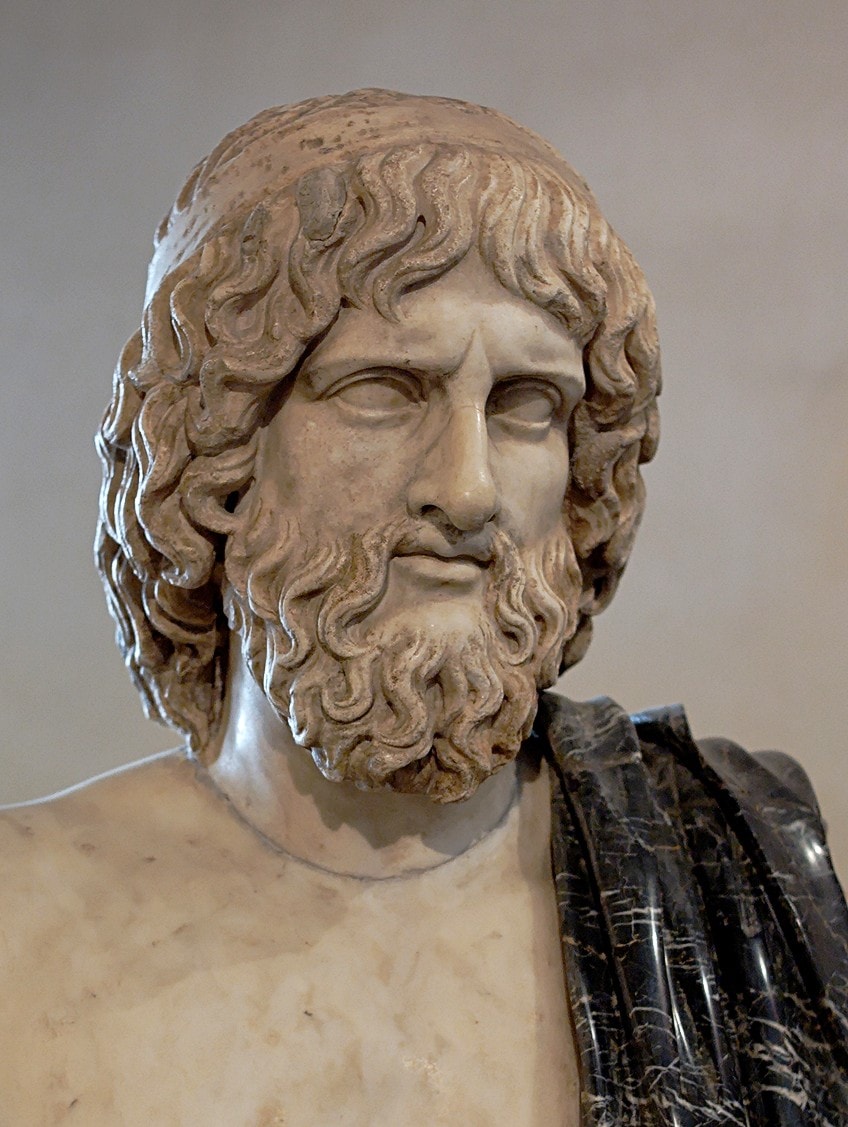 Bust of Hades; Museo nazionale romano di palazzo Altemps, Public domain, via Wikimedia Commons
Bust of Hades; Museo nazionale romano di palazzo Altemps, Public domain, via Wikimedia Commons
Hades’ Symbols
Hades’ helmet is one of his most recognizable symbols. The Cyclops gave it to him during the war between the Olympian gods and the Titans. This helmet provides him with invisibility and serves as a powerful symbol of his influence. Cerberus is the hound with three heads who guards the Underworld’s gates and it represents one of the most well-known Hades symbols.
Cerberus serves as the boundary between the realms of the living and the realms of the deceased.
The cypress tree also has an association with Hades and the land of the dead. It represents sorrow as well as eternal life. It is represented as the underworld’s gateway. Hades occasionally appeared holding a key, representing his control over the Underworld’s gates. This key symbolizes his power to give or refuse access to the underworld. Hades is sometimes portrayed wielding a scepter which symbolizes his control over the underworld.
Hades’ Domain
Not only was Hades the name of the god, but also often the name given to the underworld itself. The deity Hermes was said to transport souls to the underworld’s river Styx, where Charon, the ancient boatman, carried them to the gates of Hades, where Cerberus – a powerful three-headed hound with serpents sprouting out of its torso – kept guard in order to keep souls in instead of keeping others out. Grieving families placed a coin on the lips of the deceased as a tribute to Charon. Those unable to pay the boatman were destined to roam the world of the living as ghosts. The concept alludes to Hades’ ambiguous character.
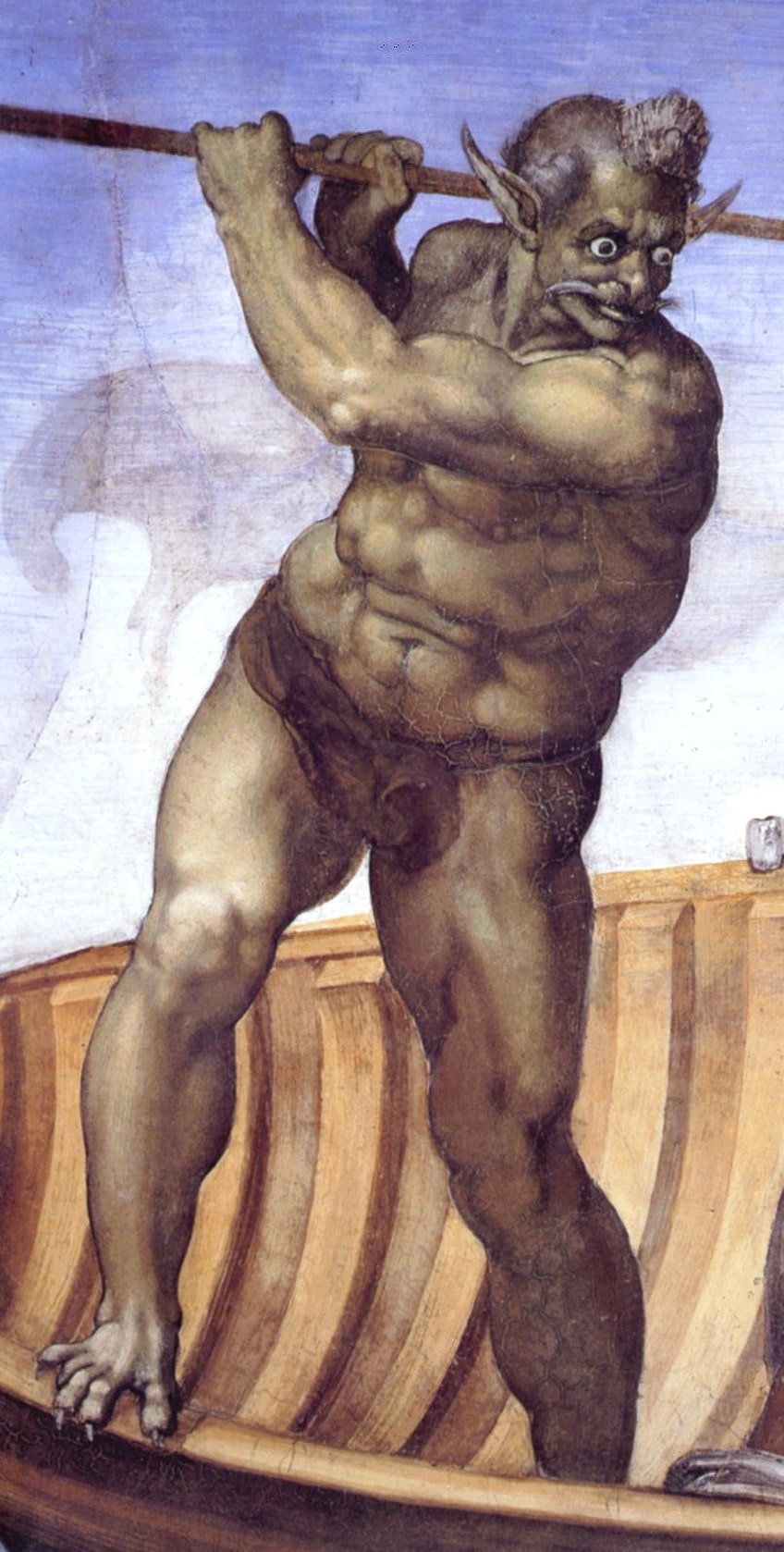 Charon as depicted by Michelangelo in his fresco The Last Judgment in the Sistine Chapel; Michelangelo, Public domain, via Wikimedia Commons
Charon as depicted by Michelangelo in his fresco The Last Judgment in the Sistine Chapel; Michelangelo, Public domain, via Wikimedia Commons
The Underworld
Hades’ domain was not always perceived as a place of agony and misery, but rather the soul’s last resting place. When souls arrived at the gates of Hades, their final location was chosen by an appraisal of what they did while alive. Traditionally, the three soul judges were Rhadamanthys, Minos, and Aiakos, all of whom lived honorable lives. Souls considered to have led particularly virtuous lives were taken first to the River Lethe to drink of its waters, which made the souls forget all negative things, and then headed for the lovely Elysian Fields. Those souls deemed to have led evil lives were placed in the possession of the Furies and transported to Tartarus, Hades’ lowest level, to be punished for their transgressions. The most heinous offenders, those who had outraged the gods by their disobedience were sentenced to endless agony.
Sisyphus, who was forced to push a rock up a hill for eternity, and Tantalos, who was unable to ever quench his perpetual thirst, were examples of those so punished.
Mythologies Regarding Hades
The most well-known myth regarding Hades is his abduction of Persephone. There are also several myths regarding various heroes who came to the underworld. There are also additional myths regarding his various lovers.
The Abduction of Persephone
Persephone, the daughter of Demeter and Zeus, was Hades’ consort. Persephone was kidnapped by Hades while she was in the fields of Nysa, gathering flowers. Demeter cursed the land in outrage at his act, and this resulted in a horrible famine. The gods came to ask that she lift it, in case humanity perishes and strips the gods of their gifts and sacrifices. However, Demeter stated that the planet would continue to be barren until she saw her child again.
Zeus then summoned his son, Hermes, and instructed him to travel to the underworld in the hopes of persuading Hades to let Persephone go back to Earth, thus causing the famine to end.
Hermes traveled down to Hades’ domain and discovered Hades sitting on a couch with Persephone next to him. Hermes carried Zeus’ message to Hades, who agreed, telling Persephone to go back to her dark-robed mother and to feel kindness in her heart towards Hades. After that, Hades prepared his chariot, but not before sneakily giving a pomegranate seed to Persephone to eat. Hermes grabbed the reins, and they made their journey to the Earth, halting in front of Demeter’s temple at Eleusis, where she had been waiting for their arrival. Persephone and Demeter rushed toward one other and embraced, overjoyed to be reunited.
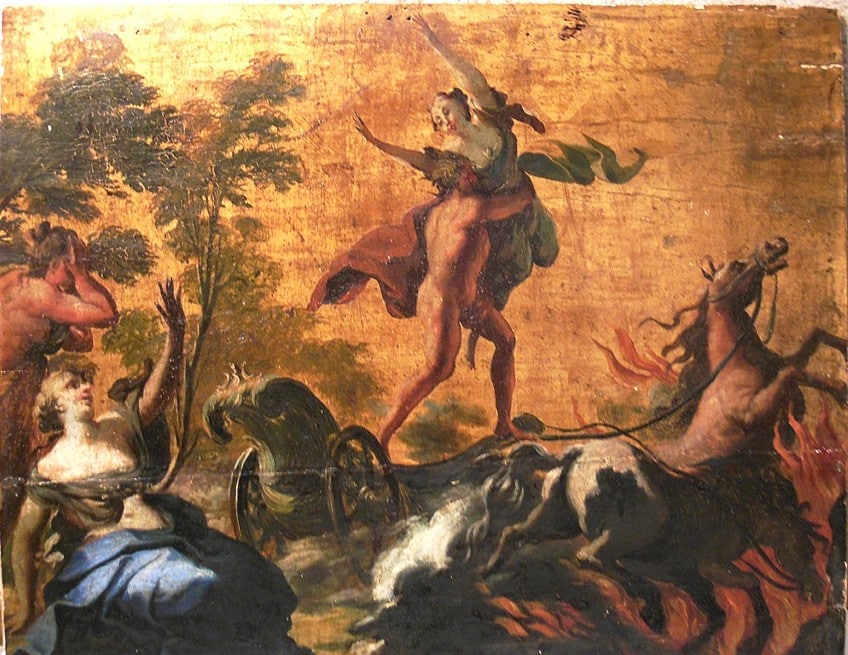 Oil painting of Hades abducting Persephone; Unidentified painter, Public domain, via Wikimedia Commons
Oil painting of Hades abducting Persephone; Unidentified painter, Public domain, via Wikimedia Commons
Demeter suspected Persephone of eating food while in the underworld and began to ask her questions. Persephone did acknowledge eating dead food, telling Demeter that Hades handed her a pomegranate seed and encouraged her to consume it. Persephone’s ingestion of the pomegranate seed bonded her to Hades, much to Demeter’s dismay. Zeus, though, had already presented a solution to which both sides had agreed: Persephone would spend one-third of the year with her husband.
Winter descends on the land during this period, while Persephone is in the underworld, bringing “mourning and sadness”.
Theseus and Pirithous
In one myth, Pirithous and Theseus vowed to capture and marry Zeus’ daughters. Theseus picked Helen, and they abducted her and planned to keep her until she was of an appropriate age to marry. Pirithous went with Persephone. They journeyed to the underworld, leaving Helen with Theseus’ mother, Aethra. Because Hades was aware of their intention to kidnap his bride, he pretended to provide them with accommodation and laid a feast; however, as soon as both of them sat down to eat, snakes curled around their ankles and kept them there. Heracles finally liberated Theseus, but Pirithous was still imprisoned as punishment for attempting to pursue the woman of the gods for himself.
 Theseus and Pirithous abducting Elena by Pelagio Palagi (1814); Pelagio Palagi (1775-1860), Public domain, via Wikimedia Commons
Theseus and Pirithous abducting Elena by Pelagio Palagi (1814); Pelagio Palagi (1775-1860), Public domain, via Wikimedia Commons
Sisyphus
Sisyphus was a king from Corinth who was condemned in Tartarus for disclosing to Asopus, the river god, the location of his daughter Aegina after Zeus stole her, as well as for attempting to evade death. Zeus, enraged at Sisyphus for divulging the secret, dispatched Thanatos to him, but Thanatos skilfully bound Death into his own shackles, so no one could die until Ares liberated Thanatos and handed Sisyphus to him.
Nonetheless, Sisyphus commanded his wife Merope not to carry out any burial rites or other forms of homage to the underworld deities before he was sent to Hades.
After some time had passed and Merope had not been properly honored, Hades learned of this and let Sisyphus return to the land of the living in order to punish his wife, with a promise that he would return later. Sisyphus, though, did not return as stated until years later, when he eventually passed away from old age. Hades condemned Sisyphus to roll a rock up a steep hill in the underworld, yet each time that he managed to get to the top, the boulder would roll all the way back down.
Heracles
Heracles’ final task was to catch Cerberus. Heracles first traveled to Eleusis to be inducted into the Eleusinian Mysteries. He did this to atone for slaying the centaurs and to find out how to get into and out of the underworld safely. At Taenarum, he discovered the door to the underworld. Hermes and Athena aided him on his journey to and from Hades. Heracles requested permission from Hades to kidnap Cerberus. On condition that Heracles did not injure Cerberus, Hades was willing to consent to his request. Heracles traveled through the grotto Acherusia when he carried the hound out of Hades. In the tale of Alcestis and Admetus, Heracles brought Alcestis back from the grave after she offered her life in the place of her husband Admetus in order to rescue him.
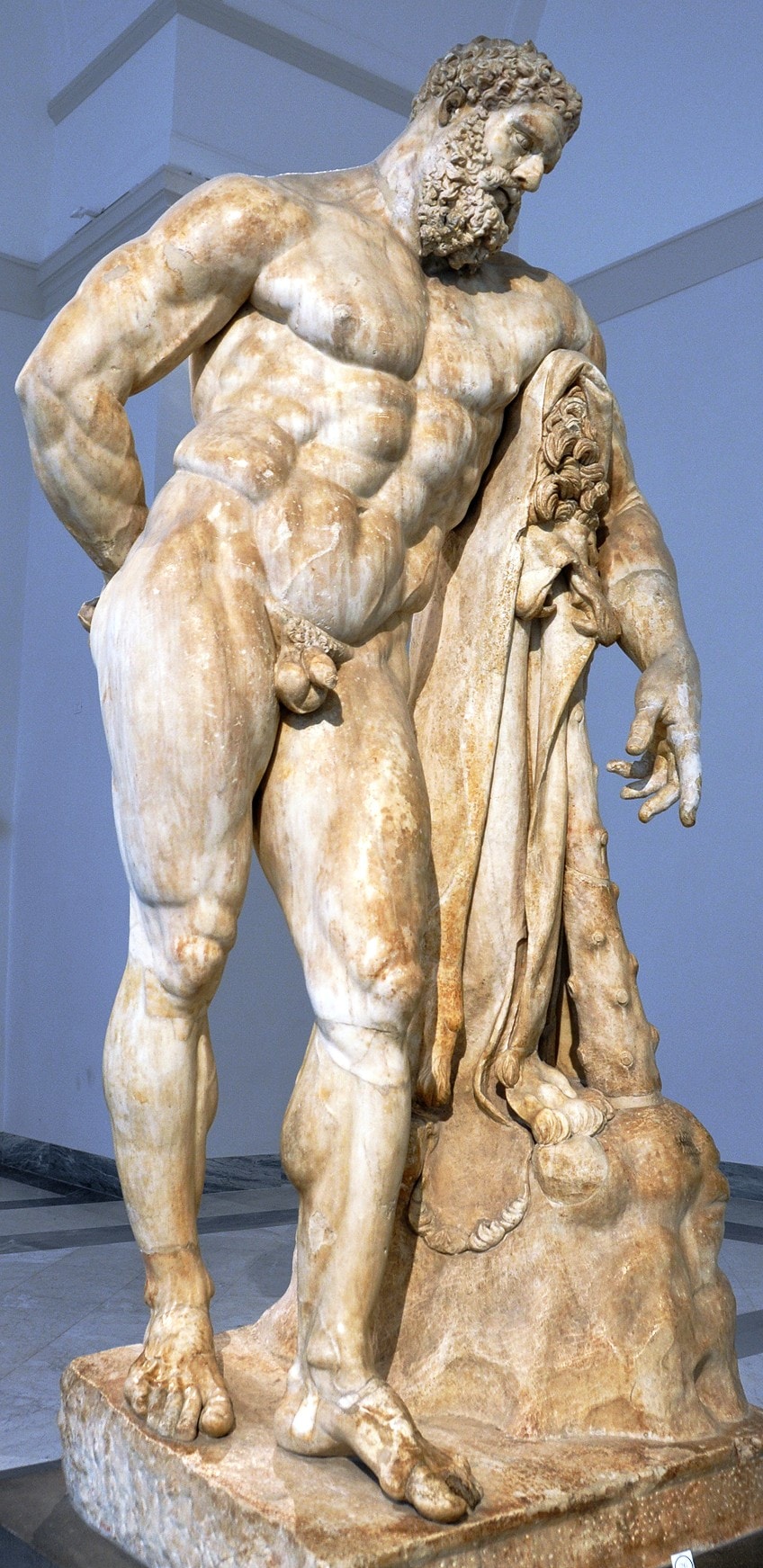 One of the most famous depictions of Heracles, Farnese Hercules; Paul Stevenson, CC BY 2.0, via Wikimedia Commons
One of the most famous depictions of Heracles, Farnese Hercules; Paul Stevenson, CC BY 2.0, via Wikimedia Commons
Hades’ Lovers
Leuce was perhaps the most gorgeous of the nymphs and Oceanus’ daughter. Hades ended up falling in love with her and took her to the underworld. She spent her whole life in his domain, and when she passed away the god sought solace by erecting a fitting tribute to their love: he erected a white tree in the Elysian Fields, where the devout spent their afterlife. Heracles crowned himself with this tree to commemorate returning from the underworld. Minthe was a Cocytus nymph, who eventually became a lover of Hades. Persephone, enraged, stomped the nymph beneath her feet.
Hades transformed his dead beloved into the mint herb after Persephone tore her apart for sleeping with him.
Artistic Representations of Hades
Because the Greeks were terrified of Hades, he was rarely represented in artwork and legend. His artistic depictions, which are commonly seen in Archaic pottery, are not even clearly regarded as the deity; yet, it is widely assumed at this period that the figures shown are actually Hades. He was later depicted in the classical arts in portrayals of Persephone’s Rape. Hades was often depicted as a youth in these pictures, although he was also depicted as a man of various ages in other works. Because of the scarcity of images, there were no strict standards for displaying the deity. On ceramics, he is shown as a majestic figure on an ebony throne with a black beard. In art, he is represented with a scepter, a headpiece, cornucopias, chickens, and a key.
The key has a dual symbolic function in that it depicts his authority over the underworld and serves as a reminder that the underworld’s gates were always closed so that souls could not exit. Even though the gates were open, Cerberus guaranteed that while all souls were welcome to enter, none were ever able to depart. Cerberus is such an intrinsic symbol of Hades that when he is shown, he is almost never depicted without Hades. Because Hades was loathed by both the other gods and humanity, painters depicted him as gazing away from them. He was regarded more positively as the Roman Pluto. He is normally shown holding a cornucopia, which represents the gifts he bestows on people in addition to fertility, with which he is often associated.
Legacy and Influence
Greek mythology has experienced a recent boom in popularity. This increased attention has contributed to Hades’ popularity, a significant character in Greek mythology. People are attracted to the rich and interesting stories of the gods and their relationships, and Hades, as the intriguing king of the underworld, is often a focal point of these stories.
Hades is typically represented as a complicated and multifaceted figure, which adds to his allure. Hades is portrayed in modern renditions as more than simply a stern and aloof ruler of the deceased.
He is given dimensionality, with his own goals, conflicts, and flaws. Audiences who enjoy complicated and ethically ambiguous individuals will appreciate this nuanced depiction. Hades has appeared in a variety of contemporary media, including television series, films, literature, and video games. In the hugely famous video game Hades by Supergiant Games, for instance, Hades takes center stage as the primary character. These versions bring Hades to new audiences and contribute to his ongoing appeal.
 Hades and Persephone, 1864; Publisher: Eduard Trewendt, Atelier für Holzschnittkunst von August Gaber in Dresden, Public domain, via Wikimedia Commons
Hades and Persephone, 1864; Publisher: Eduard Trewendt, Atelier für Holzschnittkunst von August Gaber in Dresden, Public domain, via Wikimedia Commons
Hades’ domain over the hereafter allows for the exploration of serious existential and moral issues. His character provides opportunities for reflection on the afterlife, death, and the implications of one’s conduct. These subjects are appealing to viewers looking for thought-provoking stories. Despite being a god, Hades often reflects human feelings and problems. Isolation, power dynamics, familial ties, and the search for identity are all explored by his character. These characteristics make him relatable and enable people to connect with his experiences.
That completes our look at the god of the underworld, Hades. Despite being a less prominent protagonist in mythological stories than the other Olympians, Hades must have inspired superstitious fear in many common Greeks. Indeed, even using his name was forbidden; rather, epithets such as Eubuleus (Advice-Giver) were employed. There are other stories of sacrifice acts performed in Hades’ honor at night, where the victims’ blood was allowed to flow into the soil and reach the underworld. Hades was the sole deity who did not live on Mount Olympus, instead residing in a darkened palace beneath the ground. While associated with death, he was not seen as an evil entity, but rather one who was just fulfilling his role.
Frequently Asked Questions
Who Did the Greek God Hades Choose to Be His Wife in the Underworld?
Persephone was chosen as Hades’ wife in the underworld. Hades fell in love with Persephone, Demeter’s daughter. Hades kidnapped Persephone and took her to the underworld to become his queen. Persephone spent a portion of the year in the underworld, while the other portion of the year she was permitted to return to the world above. When Persephone returned to the world above, she brought with her the entrance of spring and the budding of flowers, thereby providing Greek mythology’s explanation for the cyclical nature of the seasons.
Did Hades Have Children?
Many people believe that Macaria is the child of Hades and Persephone. She is seen occasionally as a minor underworld deity and is connected to a peaceful death. Despite conflicting versions of her paternity, Melinoe is another of Persephone and Hades’ daughters. She is referred to as a goddess of the underworld and is connected to ghosts and the night. Zagreus is occasionally described as the son of Hades and Persephone. Zagreus is linked to the Orphic tradition and is associated with mystery, rebirth, and Dionysian themes.
What Is Hades’ Domain?
Hades’ domain is regarded as the underworld in Greek mythology. It is the place where all souls end up upon death. However, the Greeks did not think of Hades as an evil devil-like entity. Rather, they regarded him to be a sort of balance keeper of both realms. Depending on how one lived their life, there are different parts of the underworld where the souls could potentially end up. Hades served as a judge, making sure that the souls receive the proper retribution or reward in accordance with their deeds on Earth. The three-headed hound of Hades, Cerberus, who forbids the living from entering and the dead from leaving, is another guardian of Hades’ domain.

I am deeply passionate about history and am constantly fascinated by the rich and complex stories of the past. As the editor-in-chief of learning-history.com, I have the opportunity to share this passion with a wide audience through the creation and distribution of engaging and informative content about historical events, persons, and cultures. Whether it’s through writing articles and blog posts or creating videos or podcasts, I strive to bring the past to life in a way that is both accurate and enjoyable. My expertise in history, combined with my strong writing and communication skills, allows me to effectively communicate complex historical concepts and make them accessible and interesting to a wide range of readers. I am truly grateful for the opportunity to share my love of history with others through my work on learning-history.com.


